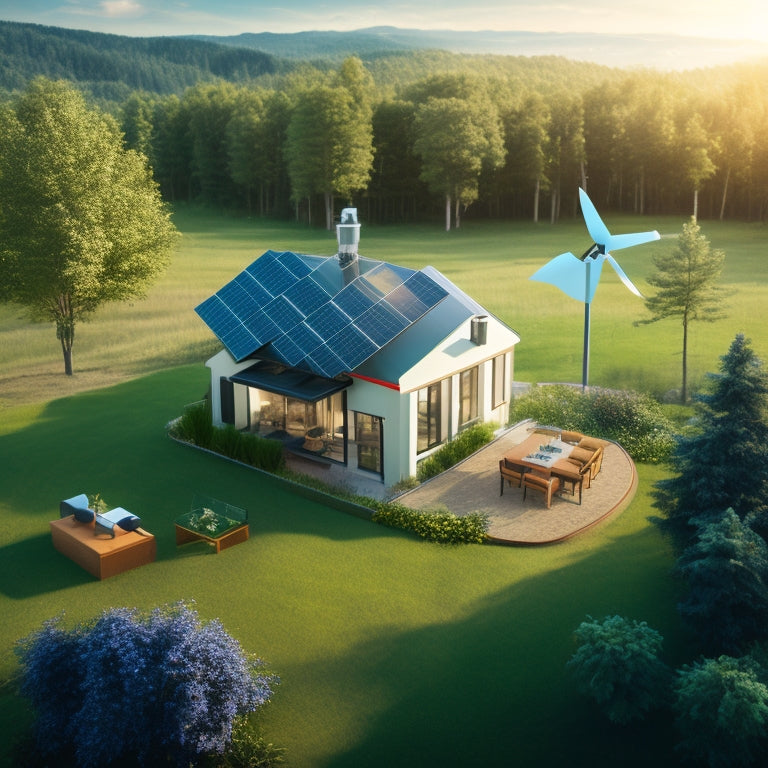
Microgrids: Your Path to Home Energy Independence
Share
By embracing renewable energy sources like solar and wind power, you can minimize your reliance on the grid and take a significant step towards achieving true home energy independence. Microgrids allow you to seamlessly integrate these sources into your energy system, reducing greenhouse gas emissions and energy bills while promoting sustainable living practices. With the right energy storage options, such as advanced battery technologies, you can guarantee a reliable and efficient energy supply. As you continue to investigate the world of microgrids, you'll uncover how to optimize energy distribution, manage energy needs, and create a pathway to self-sufficiency that aligns with your sustainability goals.
Key Takeaways
- Microgrids enable self-sustaining energy systems, providing true energy independence and enhancing community energy security.
- Seamless integration of solar panels, wind turbines, and energy storage options ensures a reliable and clean power supply.
- Advanced energy management systems optimize energy distribution, minimizing waste and maximizing energy independence.
- Off-grid capabilities and load management features guarantee uninterrupted power supply during outages and extreme weather events.
- Investing in microgrids supports climate change mitigation, promotes sustainable practices, and fosters a cleaner environment for future generations.
Embracing Renewable Energy Sources
As you investigate the concept of home energy independence through microgrids, embracing renewable energy sources becomes a crucial step.
You'll want to evaluate solar panel integration, which can provide a significant portion of your energy needs, especially during peak sunlight hours. By leveraging solar power benefits, such as reducing greenhouse gas emissions and energy bills, you can create a more sustainable energy system.
Wind turbine options are another viable alternative, offering a clean and reliable source of power. When selecting wind turbines, you'll need to assess factors such as turbine size, blade material, and noise levels to guarantee peak performance and minimal disturbance.
Carbon Neutral Home Benefits
By going carbon neutral, you'll not only reduce your environmental footprint but also reap numerous benefits that directly impact your daily life.
For instance, energy-efficient systems and appliances will reduce your energy consumption, leading to lower utility bills and increased savings.
Additionally, incorporating renewable energy sources, such as solar-powered fast charging hubs, can also reduce your reliance on fossil fuels.
A carbon-neutral home also means a healthier living space, free from pollutants and toxins that can compromise indoor air quality.
Moreover, a reduced carbon footprint translates to a smaller reliance on fossil fuels, giving you more control over your energy usage.
As you work towards energy independence, a carbon-neutral home is an essential step towards achieving that goal.
Microgrid Energy Storage Options
You've taken the first step towards energy independence by creating a carbon-neutral home. Now it's time to examine microgrid energy storage options. This is where advanced battery technologies come into play.
You'll want to investigate different types, such as lithium-ion, lead-acid, and flow batteries, each with its pros and cons. Large-scale solar farms, like those used for renewable energy sources, can also be integrated into microgrid systems, providing a reliable source of clean energy.
Energy management is also essential, as it optimizes energy distribution and storage. A sophisticated energy management system will guarantee your microgrid operates efficiently, minimizing waste and maximizing your energy independence.
Off-Grid Capabilities and Reliability
A self-sustaining microgrid's off-grid capabilities are vital to achieving true energy independence.
You'll want a system that can seamlessly shift between grid-tied and off-grid modes, ensuring uninterrupted power supply during outages or when you choose to disconnect from the grid.
Effective load management is essential in this regard, as it enables your microgrid to prioritize energy distribution and optimize resource allocation.
By leveraging renewable energy integration, you can reduce your reliance on fossil fuels and lower your carbon footprint.
This, in turn, enhances energy resilience, allowing you to weather extended grid outages or extreme weather events.
Investing in a Greener Future
As you achieve energy independence with your microgrid, the next step is to reflect on the long-term environmental benefits.
Investing in a greener future means exploring sustainable financing options that support your commitment to energy efficiency. You'll want to evaluate financing models that prioritize renewable energy sources, such as solar or wind power, and incentivize energy-saving practices.
By doing so, you'll not only reduce your carbon footprint but also minimize your reliance on fossil fuels. Additionally, integrating solar power into your microgrid can reduce grid reliance by up to 70% peak shaving, leading to significant cost savings.
Moreover, government incentives, such as tax credits and rebates, can help offset the costs of shifting to a greener energy environment.
With sustainable financing, you can optimize your microgrid's energy efficiency, ensuring a cleaner and more environmentally friendly energy supply. This forward-thinking approach will future-proof your energy independence, securing a greener tomorrow for generations to come.
Frequently Asked Questions
Can I Install a Microgrid in a Rented Property or Apartment?
You can't typically install a microgrid in a rented property without permission, but you can investigate alternatives, like portable energy storage systems, to gain some energy independence while still respecting your rental agreement's terms.
Are Microgrids Compatible With Existing Home Electrical Systems?
You'll face grid integration challenges when connecting your microgrid to your existing home electrical system, but with proper design and home energy storage, you can overcome these obstacles, ensuring a seamless shift to energy independence.
How Often Do Microgrid Components Require Maintenance or Replacement?
You'll find that microgrid components, like solar panels and inverters, typically follow strict maintenance schedules, ensuring peak performance; their lifespan varies, but with proper care, they can last 15-30 years or more, giving you reliable energy freedom.
Can I Use a Microgrid to Power My Electric Vehicle?
You can power your electric vehicle using a microgrid, leveraging EV charging from renewable sources like solar or wind, with integration strategies that optimize battery storage, while considering cost considerations for a seamless, independent driving experience.
Are There Any Government Incentives for Installing a Microgrid?
You'll find federal incentives, like the Investment Tax Credit, offering up to 30% of your microgrid's cost, and local rebates, varying by state, that can greatly reduce your upfront investment, giving you more freedom to choose your energy path.
Related Posts
-

Sustainable Scrubbing: Top Bathroom Solutions for Earth-Conscious Homes
You're taking an important step towards creating a more sustainable home by switching to eco-friendly bathroom cleani...
-

What Cool Roof Tax Breaks Can Homeowners Claim?
You can claim federal tax credits of up to $500 and state and local incentives for installing cool roofs, which not o...
-

What Are Natural Clay Paints for Green Home Interiors?
You're about to uncover a game-changing alternative to synthetic paints that not only enhances the aesthetic of your ...


